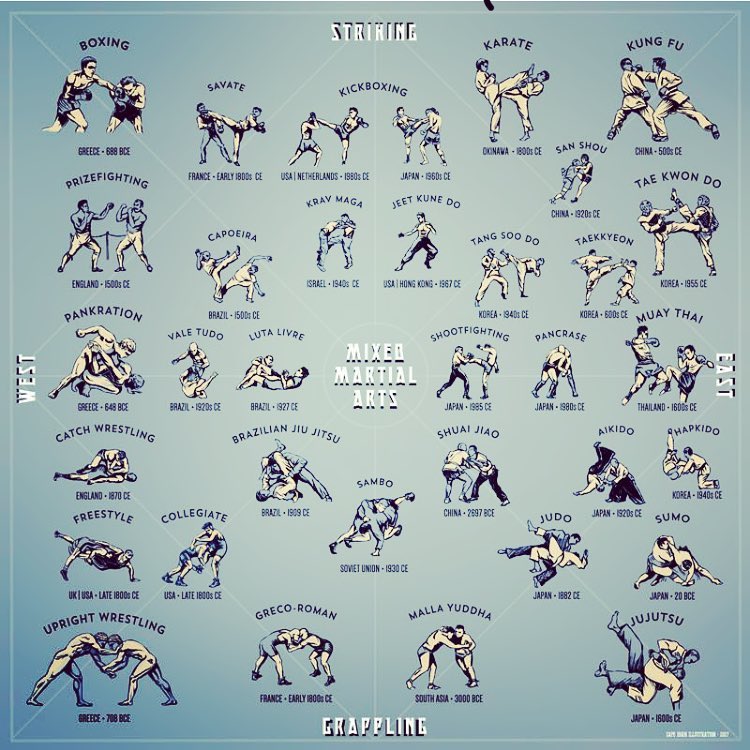The Tradition And Innovation Of Martial Arts: A Comprehensive Introduction From Its Ancient Beginnings To Existing Approaches
The Tradition And Innovation Of Martial Arts: A Comprehensive Introduction From Its Ancient Beginnings To Existing Approaches
Blog Article
Article By-Svenstrup Ayers
Enter the world of martial arts, where ancient beginnings and modern-day techniques clash in a thrilling trip of discipline and self-discovery.
As you look into the history and advancement of this captivating art kind, prepare to be astounded by the cultural influences, technological innovations, and profound viewpoint that have shaped it over centuries.
From the battlegrounds of ancient people to the training premises these days, martial arts have actually stood the test of time, constantly adjusting and expanding.
Each strike, each movement, carries with it the weight of countless years of practice and wisdom, gave with generations. This is a tale of durability, of warriors who sought not only physical prowess, yet also inner strength and harmony.
Join us on this remarkable exploration as we discover the keys, the tales, and the transformational power of martial arts.
Prepare to be motivated, tested, and permanently altered by the history and advancement of martial arts.
Social Influences on Martial Arts
As you discover the history and advancement of martial arts, you'll rapidly discover the remarkable ways in which social impacts have formed these combat strategies.
From the old human beings of China and India to the much more current developments in Japan and Brazil, martial arts have actually been greatly influenced by the societies in which they stemmed.
For example, Chinese martial arts, such as Kung Fu and Tai Chi, are deeply rooted in the viewpoint of Taoism and the concept of Yin and Yang.
On the other hand, Japanese martial arts, like Martial arts and Judo, reflect the samurai warrior traditions and the values of discipline and honor.
Similarly, Brazilian martial art, Capoeira, incorporates components of African dance and songs, showing the cultural heritage of African slaves in Brazil.
These social influences not just offer each fighting style its special attributes but likewise give a deeper understanding of the historical and social contexts in which they evolved.
Technological Advancements and Martial Arts
With the surge of innovative weapons and ingenious training tools, you've been able to boost your skills and adapt to the ever-changing combat landscape.
Technological innovations have actually changed the method martial arts are practiced and taught. Virtual reality simulations currently allow you to train in sensible battle situations without the danger of physical damage. High-speed video cameras catch every action, enabling you to analyze and best your strategies. Wearable gadgets monitor your heart rate, breathing, and muscular tissue activation, providing immediate comments on your performance.
In addition, the advancement of specialized equipment, such as resistance bands and dexterity ladders, has actually allowed you to improve your rate, stamina, and dexterity. These technical innovations have not just made training a lot more efficient yet have also pressed the limits of what is feasible in martial arts, allowing you to get to new heights in your method.
The Approach and Principles of Martial Arts
The philosophy and principles of martial arts are deeply rooted in shaping your state of mind and instilling technique, emphasis, and respect in your practice.
1. Way of thinking: Martial Arts shows you to establish a solid and durable mindset. It enables you to get rid of obstacles both on and off the mat, pressing your limits and standing firm when faced with hardship.
2. Discipline: Martial Arts needs self-control and self-discipline. With routine training and adherence to stringent rules and strategies, you find out to manage your impulses and establish a solid job values.
3. Emphasis: Martial Arts requires extreme emphasis and focus. By educating your mind to be present in the moment, you enhance your capacity to respond quickly and successfully throughout combat scenarios.
4. Respect: Martial Arts stresses respect for oneself, teachers, educating companions, and opponents. use this link teaches you to value the skills and experiences of others, cultivating a feeling of sociability and sportsmanship.
Verdict
Congratulations on completing your trip through the fascinating globe of martial arts! Throughout this expedition, you have witnessed the rich history and amazing evolution of these battle techniques.
From their old origins to the contemporary methods we see today, martial arts have actually been formed by social impacts.
The combination of modern technology has also played a significant function in transforming the method martial arts are educated and practiced in today day.
However, look at here now is important to remember that martial arts are more than just physical combat. They include extensive viewpoints and leading principles that go beyond the plain act of combating.
Take a moment to review this anachronistic experience and value just how the legacy of martial arts remains to flourish in the here and now, transcending time and boundaries.
